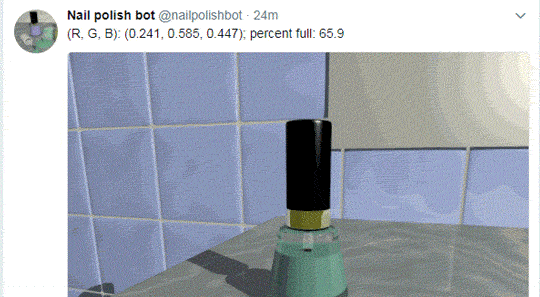
Nail Polish Bot
One thing that immediately sets Nail Polish Bot apart from other Twitter bots is that it uses 3D raytracing to generate its images. Which significantly ups the implementation complexity (it uses povray) but also expands the systemic complexity behind the image.
I’ve talked before about systems hidden behind surfaces, processes that generate outputs and so on. I’ve been circling around a theory of, let’s call it artistic information theory. Not as formal as the mathematical field, but it helps me think about generators.
We generally don’t know the inner workings of the generators other people make: the whole point is to look at the shadows they cast on the cave wall. But since the shadows repeat, we can start to detect patterns and infer what the machine looks like behind the screen. The generator’s surprise lasts until we figure out how the machine works.
A bot that generates images using a 3D raytracing process has a complicated machine to work with. In theory, a 2d process could generate amazing images: after all, a 3D renderer is just a really complex way of outputting 2d images. But when the generator is the one doing the bulk of the novel work, using a 3d raytracer gives it a lot more order and coherence.
Nail Polish Bot only changes the characteristics of the bottle. It could move the camera, change the scene, or adjust the lights but it doesn’t. The fact that it could transforms it into a minor but deliberate artistic choice.
(I don’t bother about intentionality most of the time when I’m talking about artistic choices: even if something happened by accident, the artist chose not to correct it. Consciously or unconsciously, every piece of art reflects those who made it.)
Future versions might make a different choice–that’s one of the exciting things about bots: they’re performance art by machines. You never know what the artist-machine centaur will do.
